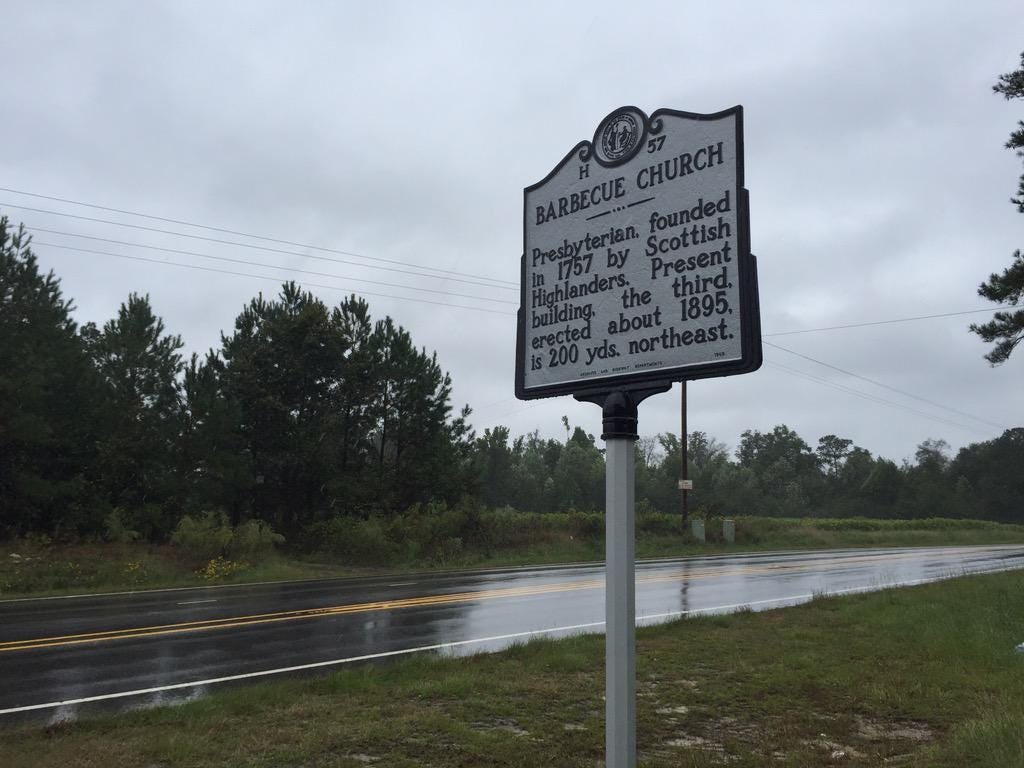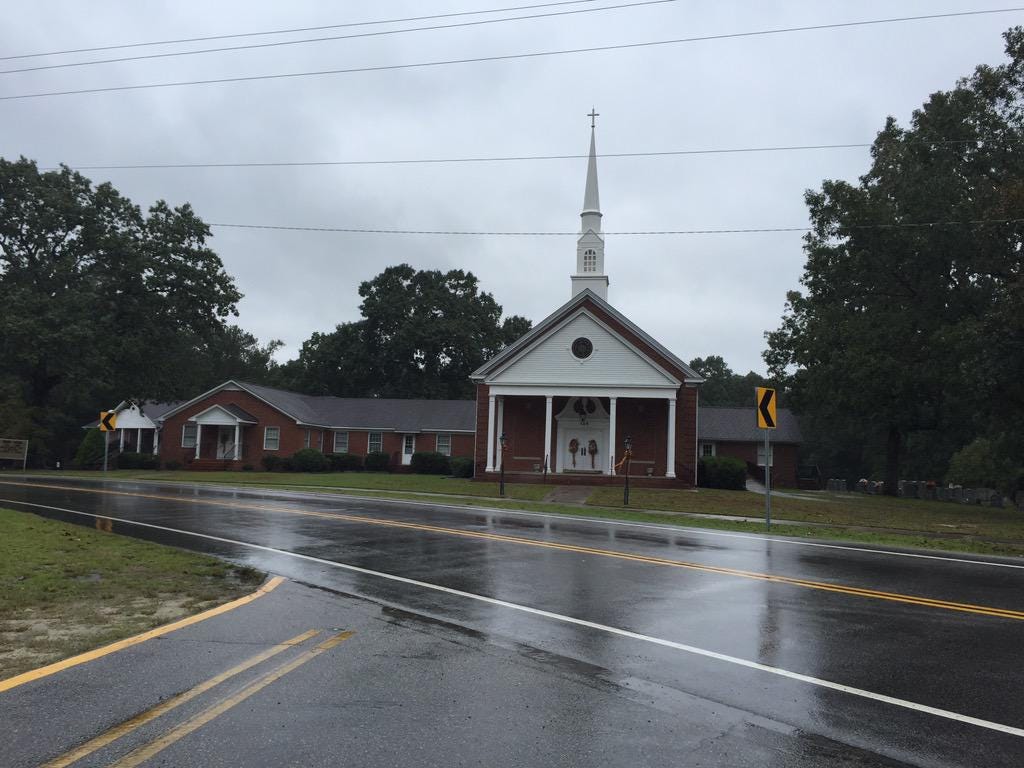Slightly Disappointing Places: Barbecue, North Carolina
A spot that shares its name with one of North Carolina's most famous foods doesn't look like much, unless you know about its history. So, um, can you get actual barbecue in Barbecue?
In 2015, I was driving across Harnett County when I came across this historical marker:
The Barbecue Church! It’s a real thing! In fact, it’s the pride of a place called Barbecue, North Carolina, which is also real! Does it occasionally make its way into dad jokes? Sure!
Barbecue ends up on lists of interesting place names in North Carolina all the time. Many of those names generally make sense. Meat Camp was once home to a primitive packing house used by hunters. Tick Bite is very much a place where a tick would bite you. The guy from the North Carolina Gazeeter wrote that Lizard Lick was named that because a “passing observer who saw many lizards sunning and licking themselves on a rail fence.” Any number of places in North Carolina are named because they were at the peak of the elevation of whatever railroad was running through it. Hence, we have High Point, Apex, Browns (or Brown) Summit, and Climax. Horneytown was named for the Horney family, you pervert. Quit stealing their road signs.
If you believe in nominative determinism, then, it would seem like Barbecue, North Carolina is the ideal spot for a barbecue joint.
But that would be causation, not correlation. So, what’s the deal with this place? What’s there? Why is there a historical marker? How did it get its name? And can you actually get barbecue there?
First off, like many interestingly-named places in North Carolina, Barbecue is not an actual town. It’s an intersection, really, where Highway 27 meets Barbecue Church Road. It’s not a popular destination either, unless you consider the Subway and Dollar General about a mile down the road. It isn’t particularly well marked. There’s no “Barbecue” sign in real life. Nor is there one for Barbecue Creek, which runs nearby. Only Barbecue Creek Park, the home to a playground and some playing fields for West Harnett High School, is a spot where you can post up for a decent Instagram selfie.
I would have just blown right past if I hadn’t seen the historical marker there (I passed through on my way to Cameron to write an Our State digital-only story that I thought was charming but ended up pissing off the all-powerful Cameron antiquing community). That marker has nothing to do with the name of the place, but rather the Presbyterian church that sits nearby.
That church has been around since 1757! The Scottish settlers nearby founded it. The first sanctuary was built from logs, then from wood. The brick structure that replaced it in the late 1800s is still there today. During the Revolutionary War, the congregants served on both sides, but worshiped in the same place. For a time, it held services in Gaelic, making it one of the few churches in the United States to do so (The enslaved people buried nearby spoke that language as well).
The church also, famously, does not lock its doors. In 2018, a reporter from the Fayetteville Observer found out why:
According to church historian Laura Cameron, the church was in its infancy in 1766 when an unknown traveler stopped to seek shelter one bitterly cold night. No one was there, and the door was locked. The stranger crouched on the doorstep. He was found the next day, frozen to death. He became the first person buried in the Barbecue Church cemetery, and his lesson made its mark on the church.
So why is the place called Barbecue, anyway? According to Cameron, the historian, an early settler named “Red” McNeill saw steam rising from the creek nearby, which reminded him of some of the barbecue pits he’d come across in the Caribbean. He started calling it Barbecue Creek, and the name has stuck for nearly three centuries since.
Also, there are tons of stories about General Cornwallis showing up and camping near the church. There’s even a buried treasure story! From the Fayetteville Observer:
Supposedly, Cornwallis ordered the soldiers’ payroll buried on the church grounds to prevent American partisans from capturing it. After the war, a huge hole was dug where the payroll was supposed to be. The hole is still visible to the west of the current church. No one knows whether a treasure was really there, and no one ever boasted of finding it. “If they did find it, they certainly didn’t tithe it,” [then-pastor Sandy] Williams said with a laugh.
The folks who researched the historical marker, though, have stated that Cornwallis couldn’t have stopped to camp there on his way from Greensboro to Wilmington in 1781, stating that records showed his army passed much further to the north. The myth may have come from a small battle nearby that people may have thought involved Cornwallis, but could have been between some local Tories and Whigs, if it happened at all. Sorry! I know that’s a downer! I, too, wanted to find THE HIDDEN GOLD OF CHARLES CORNWALLIS.
Barbecue, then, did not get its name from the actual food, but maybe from some dude in the 1750s who thought the creek reminded him of the food. So, is it possible to get barbecue in Barbecue? Yes, if you time it right. Every September, the church hosts a Harvest Festival and cook up all sorts of fantastic church food, including pork shoulders. They’ve also begun to lean into their name, selling “Blessed at Barbecue” sweatshirts with Celtic crosses on them, along with Barbecue Presbyterian Church barbecue sauce (!!!). They may do many things the old fashioned way in Barbecue, but they’re leaning into modernity in at least one way: church merch.
OTHER SLIGHTLY DISAPPOINTING PLACES:






"the guy" who wrote the North Carolina Gazetteer was iconic Prof. William S. Powell! New edition coauthored by Michael Hill of the NC Archives & History, who also the Guide to NC Historic Highway Markers. Gazetteer is underappreciated.
Is the church historian, Laura Cameron, part of the nearby Cameron of the pissed-off antiquing community?